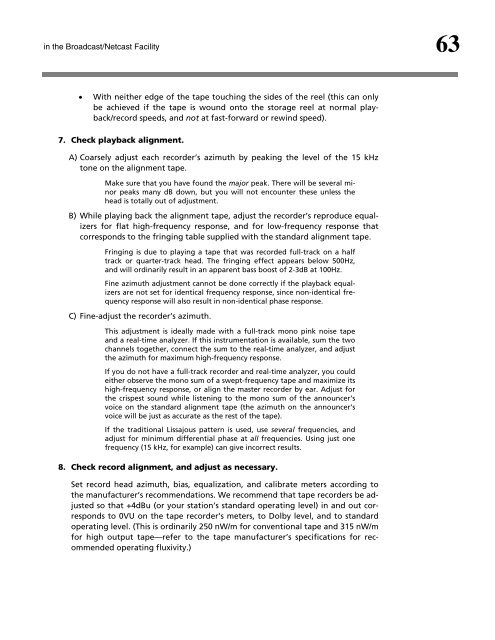Maintaining Audio Quality in the Broadcast Facility 2011 - Orban
Maintaining Audio Quality in the Broadcast Facility 2011 - Orban
Maintaining Audio Quality in the Broadcast Facility 2011 - Orban
You also want an ePaper? Increase the reach of your titles
YUMPU automatically turns print PDFs into web optimized ePapers that Google loves.
<strong>in</strong> <strong>the</strong> <strong>Broadcast</strong>/Netcast <strong>Facility</strong> 63<br />
� With nei<strong>the</strong>r edge of <strong>the</strong> tape touch<strong>in</strong>g <strong>the</strong> sides of <strong>the</strong> reel (this can only<br />
be achieved if <strong>the</strong> tape is wound onto <strong>the</strong> storage reel at normal playback/record<br />
speeds, and not at fast-forward or rew<strong>in</strong>d speed).<br />
7. Check playback alignment.<br />
A) Coarsely adjust each recorder’s azimuth by peak<strong>in</strong>g <strong>the</strong> level of <strong>the</strong> 15 kHz<br />
tone on <strong>the</strong> alignment tape.<br />
Make sure that you have found <strong>the</strong> major peak. There will be several m<strong>in</strong>or<br />
peaks many dB down, but you will not encounter <strong>the</strong>se unless <strong>the</strong><br />
head is totally out of adjustment.<br />
B) While play<strong>in</strong>g back <strong>the</strong> alignment tape, adjust <strong>the</strong> recorder’s reproduce equalizers<br />
for flat high-frequency response, and for low-frequency response that<br />
corresponds to <strong>the</strong> fr<strong>in</strong>g<strong>in</strong>g table supplied with <strong>the</strong> standard alignment tape.<br />
Fr<strong>in</strong>g<strong>in</strong>g is due to play<strong>in</strong>g a tape that was recorded full-track on a half<br />
track or quarter-track head. The fr<strong>in</strong>g<strong>in</strong>g effect appears below 500Hz,<br />
and will ord<strong>in</strong>arily result <strong>in</strong> an apparent bass boost of 2-3dB at 100Hz.<br />
F<strong>in</strong>e azimuth adjustment cannot be done correctly if <strong>the</strong> playback equalizers<br />
are not set for identical frequency response, s<strong>in</strong>ce non-identical frequency<br />
response will also result <strong>in</strong> non-identical phase response.<br />
C) F<strong>in</strong>e-adjust <strong>the</strong> recorder’s azimuth.<br />
This adjustment is ideally made with a full-track mono p<strong>in</strong>k noise tape<br />
and a real-time analyzer. If this <strong>in</strong>strumentation is available, sum <strong>the</strong> two<br />
channels toge<strong>the</strong>r, connect <strong>the</strong> sum to <strong>the</strong> real-time analyzer, and adjust<br />
<strong>the</strong> azimuth for maximum high-frequency response.<br />
If you do not have a full-track recorder and real-time analyzer, you could<br />
ei<strong>the</strong>r observe <strong>the</strong> mono sum of a swept-frequency tape and maximize its<br />
high-frequency response, or align <strong>the</strong> master recorder by ear. Adjust for<br />
<strong>the</strong> crispest sound while listen<strong>in</strong>g to <strong>the</strong> mono sum of <strong>the</strong> announcer’s<br />
voice on <strong>the</strong> standard alignment tape (<strong>the</strong> azimuth on <strong>the</strong> announcer’s<br />
voice will be just as accurate as <strong>the</strong> rest of <strong>the</strong> tape).<br />
If <strong>the</strong> traditional Lissajous pattern is used, use several frequencies, and<br />
adjust for m<strong>in</strong>imum differential phase at all frequencies. Us<strong>in</strong>g just one<br />
frequency (15 kHz, for example) can give <strong>in</strong>correct results.<br />
8. Check record alignment, and adjust as necessary.<br />
Set record head azimuth, bias, equalization, and calibrate meters accord<strong>in</strong>g to<br />
<strong>the</strong> manufacturer’s recommendations. We recommend that tape recorders be adjusted<br />
so that +4dBu (or your station’s standard operat<strong>in</strong>g level) <strong>in</strong> and out corresponds<br />
to 0VU on <strong>the</strong> tape recorder’s meters, to Dolby level, and to standard<br />
operat<strong>in</strong>g level. (This is ord<strong>in</strong>arily 250 nW/m for conventional tape and 315 nW/m<br />
for high output tape—refer to <strong>the</strong> tape manufacturer’s specifications for recommended<br />
operat<strong>in</strong>g fluxivity.)



![[PDF] Using the ITU BS.1770-2 and CBS Loudness Meters ... - Orban](https://img.yumpu.com/50629372/1/190x245/pdf-using-the-itu-bs1770-2-and-cbs-loudness-meters-orban.jpg?quality=85)






![[PDF] Optimod-FM Feature Comparison - Orban](https://img.yumpu.com/41741615/1/190x245/pdf-optimod-fm-feature-comparison-orban.jpg?quality=85)






